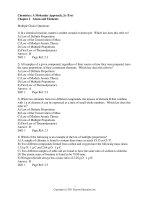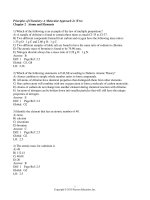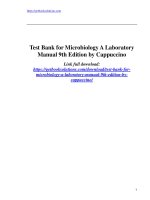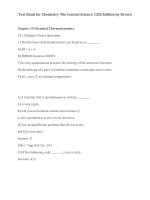Test bank for chemistry a molecular approach 2nd edition by tro
Bạn đang xem bản rút gọn của tài liệu. Xem và tải ngay bản đầy đủ của tài liệu tại đây (334.12 KB, 46 trang )
Test Bank for Chemistry A Molecular Approach 2nd Edition by Tro
Link download full: />
Sample
Chemistry: A Molecular Approach, 2e (Tro)
Chapter 10 Chemical Bonding II: Molecular Shapes, Valence Bond Theory,
and Molecular Orbital Theory
Multiple Choice Questions
1) Give the approximate bond angle for a molecule with a trigonal planar shape.
109.
110.
111.
112.
113.
A) 109.5°
B) 180°
C) 120°
D) 105°
E) 90°
Answer: C
Diff: 2
Page Ref: 10.2
2) Give the approximate bond angle for a molecule with a tetrahedral shape.
109.
110.
111.
112.
113.
A) 109.5°
B) 180°
C) 120°
D) 105°
E) 90°
Answer: A
Diff: 2
Page Ref: 10.2
3) Give the approximate bond angle for a molecule with a linear shape.
109.
110.
111.
112.
113.
A) 109.5°
B) 180°
C) 120°
D) 105°
E) 90°
Answer: B
Diff: 2
Page Ref: 10.2
4) Give the approximate bond angle for a molecule with an octahedral shape.
109.
110.
111.
112.
113.
A) 109.5°
B) 180°
C) 120°
D) 105°
E) 90°
Answer: E
Diff: 2
Page Ref: 10.2
5) Determine the electron geometry (eg) and molecular geometry(mg) of BCl3.
1.
2.
3.
4.
5.
A) eg=trigonal planar, mg=trigonal planar
B) eg=tetrahedral, mg=trigonal planar
C) eg=tetrahedral, mg=trigonal pyramidal
D) eg=trigonal planar, mg=bent
E) eg=trigonal bipyramidal, mg= trigonal bipyramidal
Answer: A
Diff: 2
Page Ref: 10.2
6) Determine the electron geometry (eg) and molecular geometry (mg) of CO32⁻.
1.
2.
3.
4.
5.
A) eg=tetrahedral, mg=tetrahedral
B) eg=tetrahedral, mg=trigonal pyramidal
C) eg=trigonal planar, mg=bent
D) eg=trigonal planar, mg=trigonal planar
E) eg=tetrahedral, mg=trigonal planar
Answer: D
Diff: 2
Page Ref: 10.2
7) Determine the electron geometry (eg) and molecular geometry (mg) of CH3+1.
1.
2.
3.
4.
5.
A) eg=tetrahedral, mg=tetrahedral
B) eg=tetrahedral, mg=trigonal pyramidal
C) eg=trigonal planar, mg=bent
D) eg=trigonal planar, mg=trigonal planar
E) eg=tetrahedral, mg=trigonal planar
Answer: D
Diff: 2
Page Ref: 10.2
8) Determine the electron geometry (eg) and molecular geometry (mg) of SiF4.
1.
2.
3.
4.
5.
A) eg=tetrahedral, mg=trigonal pyramidal
B) eg=octahedral, mg=square planar
C) eg=trigonal bipyramidal, mg=trigonal pyramidal
D) eg=tetrahedral, mg=bent
E) eg=tetrahedral, mg=tetrahedral
Answer: E
Diff: 2
Page Ref: 10.2
9) Determine the electron geometry (eg) and molecular geometry (mg) of PF5.
1.
2.
3.
4.
5.
A) eg=trigonal bipyramidal, mg=trigonal bipyramidal
B) eg=octahedral, mg=octahedral
C) eg=trigonal bipyramidal, mg=tetrahedral
D) eg=tetrahedral, mg=trigonal pyramidal
E) eg=trigonal planar, mg=octahedral
Answer: A
Diff: 2
Page Ref: 10.2
10) Determine the electron geometry (eg) and molecular geometry (mg) of CO2.
1.
2.
3.
4.
5.
A) eg=tetrahedral, mg=tetrahedral
B) eg=linear, mg=trigonal planar
C) eg=trigonal planar, mg=bent
D) eg=linear, mg=linear
E) eg=trigonal planar, mg=trigonal planar
Answer: D
Diff: 2
Page Ref: 10.2
11) Determine the electron geometry (eg) and molecular geometry (mg) of NCl3.
1.
2.
3.
4.
5.
A) eg=tetrahedral, mg=tetrahedral
B) eg=linear, mg=trigonal planar
C) eg=trigonal planar, mg=bent
D) eg=linear, mg=linear
E) eg=tetrahedral, mg=trigonal pyramidal
Answer: E
Diff: 2
Page Ref: 10.2
12) Determine the electron geometry (eg) and molecular geometry (mg) of BrF3.
1.
2.
3.
4.
5.
A) eg=trigonal planar, mg=trigonal planar
B) eg=trigonal bipyramidal, mg= T-shape
C) eg=trigonal planar, mg=bent
D) eg=trigonal bipyramidal, mg=see-saw
E) eg=tetrahedral, mg=trigonal pyramidal
Answer: B
Diff: 3
Page Ref: 10.4
13) Determine the electron geometry (eg) and molecular geometry (mg) of ICl2⁻.
1.
2.
3.
4.
5.
A) eg=tetrahedral, mg=bent
B) eg=tetrahedral, mg=trigonal pyramidal
C) eg=trigonal bipyramidal, mg=linear
D) eg=trigonal bipyramidal, mg=trigonal planar
E) eg=octahedral, mg=linear
Answer: C
Diff: 3
Page Ref: 10.4
14) Determine the electron geometry (eg) and molecular geometry (mg) of XeF2.
1.
2.
3.
4.
5.
A) eg=trigonal bipyramidal, mg=bent
B) eg=linear, mg=linear
C) eg=tetrahedral, mg=linear
D) eg=trigonal bipyramidal, mg=linear
E) eg=tetrahedral, mg=bent
Answer: D
Diff: 3
Page Ref: 10.4
15) Determine the electron geometry (eg) and molecular geometry (mg) of XeF4.
1.
2.
3.
4.
5.
A) eg=tetrahedral, mg=tetrahedral
B) eg=linear, eg=linear
C) eg=tetrahedral, mg=bent
D) eg=trigonal bipyramidal, mg=tetrahedral
E) eg=octahedral, mg=square planar
Answer: E
Diff: 3
Page Ref: 10.4
16) Determine the electron geometry (eg) and molecular geometry (mg) of the
underlined atom CH3OCH3.
1.
2.
3.
4.
5.
A) eg=tetrahedral, mg=tetrahedral
B) eg=linear, eg=linear
C) eg=tetrahedral, mg=bent
D) eg=trigonal bipyramidal, mg=tetrahedral
E) eg=octahedral, mg=square planar
Answer: A
Diff: 3
Page Ref: 10.4
17) Determine the electron geometry (eg) and molecular geometry (mg) of the
underlined atom CH3OCH3.
1.
2.
3.
4.
A) eg=tetrahedral, mg=tetrahedral
B) eg=linear, eg=linear
C) eg=tetrahedral, mg=bent
D) eg=trigonal bipyramidal, mg=tetrahedral
5. E) eg=octahedral, mg=square planar
Answer: C
Diff: 3
Page Ref: 10.4
18) Consider the molecule below. Determine the molecular geometry at each of
the 2 labeled carbons.
1.
2.
3.
4.
5.
A) C1 = tetrahedral, C2 = linear
B) C1 = trigonal planar, C2= bent
C) C1 = bent, C2 = trigonal planar
D) C1 = trigonal planar, C2 = tetrahedral
E) C1 = trigonal pyramidal, C2 = see-saw
Answer: D
Diff: 3
Page Ref: 10.4
19) Consider the molecule below. Determine the molecular geometry at each of
the 3 labeled atoms.
1.
2.
3.
4.
5.
A) 1=trigonal planar, 2=tetrahedral, 3=trigonal pyramidal
B) 1=tetrahedral, 2=tetrahedral, 3=tetrahedral
C) 1=trigonal planar, 2=tetrahedral, 3=tetrahedral
D) 1=tetrahedral, 2=tetrahedral, 3=trigonal planar
E) 1=trigonal planar, 2=trigonal pyramidal, 3=trigonal pyramidal
Answer: A
Diff: 3
Page Ref: 10.4
20) Place the following in order of increasing X-Se-X bond angle, where X
represents the outer atoms in each molecule.
SeO2
1.
2.
3.
4.
5.
SeCl6
SeF2
A) SeCl6 < SeF2 < SeO2
B) SeF2 < SeO2 < SeCl6
C) SeF2 < SeCl6 < SeO2
D) SeO2 < SeF2 < SeCl6
E) SeCl6 < SeO2 < SeF2
Answer: A
Diff: 4
Page Ref: 10.4
21) Place the following in order of increasing F-A-F bond angle, where A
represents the central atom in each molecule.
PF3
1.
2.
3.
4.
5.
OF2
PF4⁺
A) PF3 < OF2 < PF4⁺
B) OF2 < PF3 < PF4⁺
C) OF2 < PF4⁺ < PF3
D) PF4⁺ < OF2 < PF3
E) PF4⁺ < PF3 < OF2
Answer: B
Diff: 4
Page Ref: 10.4
22) Place the following in order of decreasing X-A-X bond angle, where A
represents the central atom and X represents the outer atoms in each molecule.
N2O
1.
2.
3.
4.
5.
NCl3
NO2⁻
A) NCl3 > NO2⁻ > N2O
B) NO2⁻ > N2O > NCl3
C) N2O > NO2⁻ > NCl3
D) NCl3 > N2O > NO2⁻
E) N2O > NCl3 > NO2⁻
Answer: C
Diff: 4
Page Ref: 10.4
23) Place the following in order of decreasing X-A-X bond angle, where A
represents the central atom and X represents the outer atoms in each molecule.
CS2
1.
2.
3.
4.
5.
CF4
SCl2
A) CS2= SCl2 > CF4
B) SCl2 > CF4 > CS2
C) CF4 > CS2 > SCl2
D) CS2 > CF4 > SCl2
E) CF4 > CS2 > SCl2
Answer: D
Diff: 4
Page Ref: 10.4
24) Place the following in order of increasing X-A-X bond angle, where A
represents the central atom and X represents the outer atoms in each molecule.
HCN
1.
2.
3.
4.
5.
H2O
H3O⁺
A) H2O < H3O⁺ < HCN
B) H3O⁺ < H2O < HCN
C) HCN < H3O⁺ < H2O
D) H2O < HCN < H3O⁺
E) H2O < H3O⁺ < HCN
Answer: E
Diff: 4
Page Ref: 10.4
25) A pilot checks for water in the gas before flying a small airplane. How does
she do it?
1.
2.
3.
4.
5.
A) Drain a little bit of gas from the bottom and look for two layers.
B) Smell it.
C) Shake the wings.
D) Pipet the liquid from the top of the tank and look for two layers.
E) Check the gas gauge.
Answer: A
Diff: 1
Page Ref: 10.5
26) Determine the electron geometry (eg), molecular geometry (mg), and polarity
of SO3.
1.
2.
3.
4.
5.
A) eg=tetrahedral, mg=trigonal pyramidal, polar
B) eg=tetrahedral, mg=tetrahedral, nonpolar
C) eg=trigonal planar, mg=trigonal planar, nonpolar
D) eg= trigonal bipyramidal, mg=trigonal planar, polar
E) eg=trigonal pyramidal, mg=bent, nonpolar
Answer: C
Diff: 2
Page Ref: 10.5
27) How many of the following molecules are polar?
BrCl3
1.
2.
3.
4.
5.
CS2
SiF4
SO3
A) 1
B) 2
C) 3
D) 4
E) 0
Answer: A
Diff: 3
Page Ref: 10.5
28) How many of the following molecules are polar?
XeCl2
COF2
1. A) 0
2. B) 3
PCl4F
SF6
3. C) 1
4. D) 2
5. E) 4
Answer: B
Diff: 3
Page Ref: 10.5
29) How many of the following molecules are polar?
XeO2
1.
2.
3.
4.
5.
SiCl2Br2 C2Br2 SeCl6
A) 1
B) 4
C) 2
D) 3
E) 0
Answer: C
Diff: 3
Page Ref: 10.5
30) How many of the following molecules are polar?
PCl5
1.
2.
3.
4.
COS
A) 2
B) 0
C) 1
D) 3
XeO3
SeBr2
5. E) 4
Answer: D
Diff: 3
Page Ref: 10.5
31) Determine the electron geometry (eg), molecular geometry (mg), and polarity
of SO2.
1.
2.
3.
4.
5.
A) eg=tetrahedral, mg=bent, polar
B) eg=trigonal planar, mg=bent, polar
C) eg=linear, mg=linear, nonpolar
D) eg=tetrahedral, mg=tetrahedral, nonpolar
E) eg=trigonal pyramidal, mg=trigonal pyramidal, polar
Answer: B
Diff: 3
Page Ref: 10.5
32) Determine the electron geometry, molecular geometry and polarity of SF6 .
1.
2.
3.
4.
5.
A) eg=trigonal bipyramidal, mg=trigonal bipyramidal, nonpolar
B) eg=tetrahedral, mg=tetrahedral, polar
C) eg=trigonal bipyramidal, mg=see-saw, polar
D) eg=octahedral, mg=trigonal bipyramidal, nonpolar
E) eg=octahedral, mg=octahedral, nonpolar
Answer: E
Diff: 3
Page Ref: 10.5
33) Determine the electron geometry, molecular geometry and polarity of TeCl6.
1. A) eg=octahedral, mg=octahedral, nonpolar
2. B) eg=trigonal bipyramidal, mg=trigonal bipyramidal, nonpolar
3. C) eg=octahedral, mg=square planar, polar
4. D) eg=trigonal bipyramidal, mg=see-saw, polar
5. E) eg=tetrahedral, mg=trigonal pyramidal, polar
Answer: A
Diff: 3
Page Ref: 10.5
34) Determine the electron geometry (eg), molecular geometry(mg) and polarity of
XeO3.
1.
2.
3.
4.
5.
A) eg=trigonal planar, mg=trigonal planar, nonpolar
B) eg=tetrahedral, mg=trigonal pyramidal, polar
C) eg=trigonal planar, mg=trigonal pyramidal, polar
D) eg=trigonal bipyramidal, mg=trigonal planar, nonpolar
E) eg=octahedral, mg=tetrahedral, nonpolar
Answer: B
Diff: 3
Page Ref: 10.5
35) Determine the electron geometry, molecular geometry and polarity of HBrO2 .
1.
2.
3.
4.
5.
A) eg=trigonal bipyramidal, mg=trigonal planar, nonpolar
B) eg=octahedral, mg=square planar, nonpolar
C) eg=tetrahedral, mg=trigonal pyramidal, polar
D) eg=tetrahedral, mg=linear, nonpolar
E) eg=linear, mg=linear, polar
Answer: C
Diff: 3
Page Ref: 10.5
36) Determine the electron geometry, molecular geometry and polarity of XeF6 .
1. A) eg=trigonal bipyramidal, mg=trigonal bipyramidal, nonpolar
2. B) eg=tetrahedral, mg=tetrahedral, polar
3. C) eg=trigonal bipyramidal, mg=see-saw, polar
4. D) eg=octahedral, mg=trigonal bipyramidal, nonpolar
5. E) eg=octahedral, mg=octahedral, nonpolar
Answer: E
Diff: 3
Page Ref: 10.5
37) Choose the compound below that contains at least one polar covalent bond, but
is nonpolar.
1.
2.
3.
4.
5.
A) HCN
B) CF4
C) SeBr4
D) ICl3
E) Both B and C are nonpolar and contain a polar covalent bond.
Answer: B
Diff: 3
Page Ref: 10.5
38) Choose the compound below that contains at least one polar covalent bond, but
is nonpolar.
1.
2.
3.
4.
5.
A) GeH2Br2
B) SCl2
C) AsCl5
D) CF2Cl2
E) All of the above are nonpolar and contain a polar covalent bond.
Answer: C
Diff: 3
Page Ref: 10.5
39) Place the following in order of increasing dipole moment.
1. BCl3
1.
2.
3.
4.
5.
II. BIF2
III. BClF2
A) I < II = III
B) II < III < I
C) I < II < III
D) II < I < III
E) I < III < II
Answer: E
Diff: 3
Page Ref: 10.5
40) Place the following in order of decreasing dipole moment.
1. cis-CHCl=CHCl II. trans-CHCl=CHCI
1.
2.
3.
4.
5.
III. cis-CHF=CHF
A) III > I > II
B) II > I > III
C) I > III > II
D) II > III > I
E) I = III > II
Answer: A
Diff: 3
Page Ref: 10.5
41) Determine the electron geometry, molecular geometry and polarity of N2O (N
central).
1. A) eg=linear, mg=linear, nonpolar
2. B) eg=tetrahedral, mg=linear, nonpolar
3. C) eg=tetrahedral, mg=bent, polar
4. D) eg= linear, mg=linear, polar
5. E) eg=trigonal planar, mg=bent, polar
Answer: D
Diff: 4
Page Ref: 10.5
42) Describe a pi bond.
1.
2.
3.
4.
5.
A) side by side overlap of p orbitals
B) end to end overlap of p orbitals
C) s orbital overlapping with the end of a p orbital
D) overlap of two s orbitals
E) p orbital overlapping with a d orbital
Answer: A
Diff: 1
Page Ref: 10.7
43) Describe a sigma bond.
1.
2.
3.
4.
5.
A) side by side overlap of p orbitals
B) end to end overlap of p orbitals
C) s orbital overlapping with the side of a p orbital
D) overlap of two s orbitals
E) p orbital overlapping with a d orbital
Answer: B
Diff: 1
Page Ref: 10.7
44) A molecule containing a central atom with sp hybridization has a(n)
__________ electron geometry.
1.
2.
3.
4.
5.
A) linear
B) trigonal bipyramidal
C) trigonal planar
D) tetrahedral
E) bent
Answer: A
Diff: 1
Page Ref: 10.7
45) Identify the number of electron groups around a molecule with sp
hybridization.
1.
2.
3.
4.
5.
A) 1
B) 2
C) 3
D) 4
E) 5
Answer: B
Diff: 1
Page Ref: 10.7
46) A molecule containing a central atom with sp2 hybridization has a(n)
__________ electron geometry.
1.
2.
3.
4.
5.
A) linear
B) trigonal bipyramidal
C) trigonal planar
D) tetrahedral
E) bent
Answer: C
Diff: 1
Page Ref: 10.7
47) Identify the number of electron groups around a molecule with
sp2 hybridization.
1.
2.
3.
4.
5.
A) 1
B) 2
C) 3
D) 4
E) 5
Answer: C
Diff: 1
Page Ref: 10.7
48) A molecule containing a central atom with sp3 hybridization has a(n)
__________ electron geometry.
1.
2.
3.
4.
5.
A) linear
B) trigonal bipyramidal
C) octahedral
D) tetrahedral
E) bent
Answer: D
Diff: 1
Page Ref: 10.7
49) Identify the number of electron groups around a molecule with a tetrahedral
shape.
1.
2.
3.
4.
5.
A) 1
B) 2
C) 3
D) 4
E) 5
Answer: D
Diff: 1
Page Ref: 10.7
50) A molecule containing a central atom with sp3d hybridization has a(n)
__________ electron geometry.
1.
2.
3.
4.
5.
A) tetrahedral
B) linear
C) octahedral
D) trigonal planar
E) trigonal bipyramidal
Answer: E
Diff: 1
Page Ref: 10.7
51) Identify the number of electron groups around a molecule with a trigonal
bipyramidal shape.
1.
2.
3.
4.
5.
A) 1
B) 2
C) 3
D) 4
E) 5
Answer: E
Diff: 1
Page Ref: 10.7
52) A molecule containing a central atom with sp3d2 hybridization has a(n)
__________ electron geometry.
1.
2.
3.
4.
A) octahedral
B) trigonal bipyramidal
C) tetrahedral
D) trigonal planar
5. E) trigonal pyramidal
Answer: A
Diff: 1
Page Ref: 10.7
53) Determine the electron geometry (eg) and molecular geometry (mg) of the
underlined carbon in CH3CN.
1.
2.
3.
4.
5.
A) eg=tetrahedral, mg=tetrahedral
B) eg=linear, mg=trigonal planar
C) eg=trigonal planar, mg=bent
D) eg=linear, mg=linear
E) eg=trigonal planar, mg=trigonal planar
Answer: D
Diff: 2
Page Ref: 10.7
54) Determine the electron geometry (eg) and molecular geometry (mg) of the
underlined carbon in CH3CN.
1.
2.
3.
4.
5.
A) eg=tetrahedral, mg=tetrahedral
B) eg=linear, mg=trigonal planar
C) eg=trigonal planar, mg=bent
D) eg=linear, mg=linear
E) eg=trigonal planar, mg=trigonal planar
Answer: A
Diff: 2
Page Ref: 10.7
55) Determine the electron geometry (eg) and molecular geometry (mg) of H2CO.
1.
2.
3.
4.
A) eg=tetrahedral, mg=tetrahedral
B) eg=linear, mg=trigonal planar
C) eg=trigonal planar, mg=bent
D) eg=linear, mg=linear
5. E) eg=trigonal planar, mg=trigonal planar
Answer: E
Diff: 2
Page Ref: 10.7
56) Draw the Lewis structure for OF2. What is the hybridization on the O atom?
1.
2.
3.
4.
5.
A) sp
B) sp3
C) sp2
D) sp3d
E) sp3d2
Answer: B
Diff: 3
Page Ref: 10.7
57) Draw the Lewis structure for H3O+. What is the hybridization on the O atom?
1.
2.
3.
4.
5.
A) sp
B) sp3
C) sp2
D) sp3d
E) sp3d2
Answer: B
Diff: 3
Page Ref: 10.7
58) Draw the Lewis structure for SO3. What is the hybridization on the S atom?
1.
2.
3.
4.
5.
A) sp
B) sp3
C) sp2
D) sp3d
E) sp3d2
Answer: C
Diff: 3
Page Ref: 10.7
59) Draw the Lewis structure for BrO4⁻. What is the hybridization on the Br
atom?
1.
2.
3.
4.
5.
A) sp
B) sp3d2
C) sp3d
D) sp3
E) sp2
Answer: D
Diff: 3
Page Ref: 10.7
60) Draw the Lewis structure for SF6. What is the hybridization on the S atom?
1.
2.
3.
4.
5.
A) sp
B) sp2
C) sp3
D) sp3d
E) sp3d2
Answer: E
Diff: 3
Page Ref: 10.7
61) Draw the Lewis structure for BrF5. What is the hybridization on the Br atom?
1.
2.
3.
4.
5.
A) sp3d2
B) sp3d
C) sp3
D) sp2
E) sp
Answer: A
Diff: 3
Page Ref: 10.7
62) Draw the Lewis structure for BrCl3. What is the hybridization on the Br atom?
1.
2.
3.
4.
5.
A) sp3d2
B) sp3d
C) sp3
D) sp2
E) sp
Answer: B
Diff: 3
Page Ref: 10.7
63) Consider the molecule below. Determine the hybridization at each of the 2
labeled carbons.
1.
2.
3.
4.
5.
A) C1 = sp3, C2 = sp3d
B) C1 = sp, C2 = sp2
C) C1 = sp2, C2 = sp3d
D) C1 = sp3d, C2 = sp3d2
E) C1 = sp2, C2 = sp3
Answer: E
Diff: 4
Page Ref: 10.7
64) Consider the molecule below. Determine the hybridization at each of the 3
labeled atoms.
1.
2.
3.
4.
5.
A) 1=sp2, 2=sp3, 3=sp2
B) 1=sp2, 2=sp3, 3=sp3
C) 1=sp3, 2=sp3, 3=sp3
D) 1=sp3, 2=sp3, 3=sp2
E) 1=sp, 2=sp2, 3=sp2
Answer: B
Diff: 4
Page Ref: 10.7
65) How many of the following molecules have sp hybridization on the central
atom?
C2Cl2
1.
2.
3.
4.
5.
CO2
O3
H2O
A) 0
B) 1
C) 2
D) 3
E) 4
Answer: C
Diff: 4
Page Ref: 10.7
66) How many of the following molecules have sp3 hybridization on the central
atom?
XeCl4
CH4
SF4
C2H2









